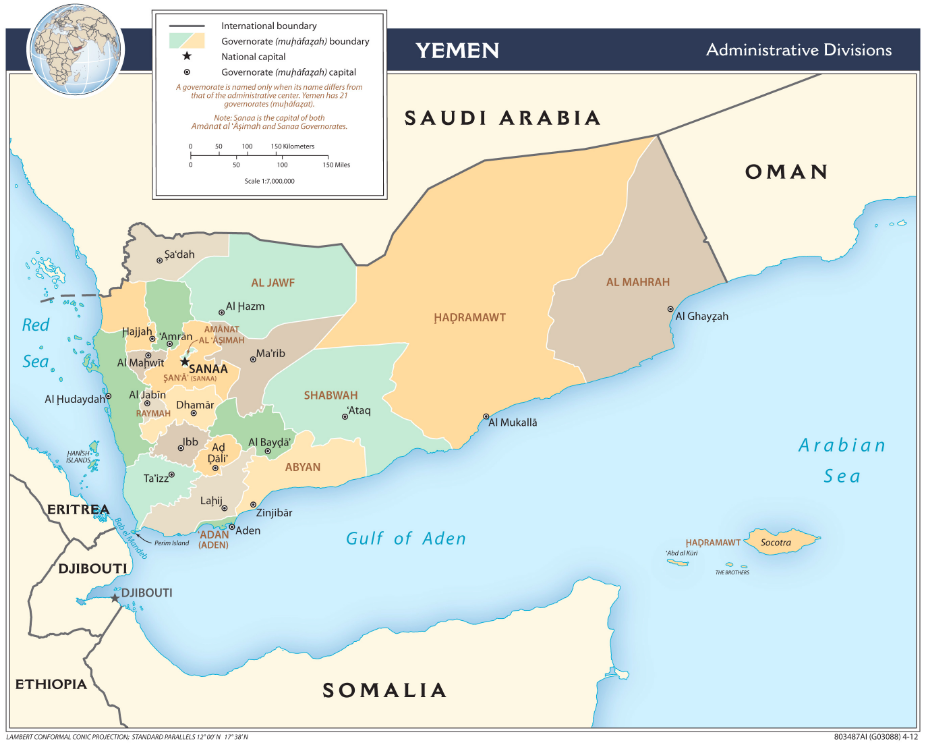
The House on Monday passed a non-binding resolution urging a political solution to conflict in Yemen, saying the two existing Authorizations for the Use of Military Force do not cover military operations against Houthi rebels in that country. Map source: CIA.
The House on Monday declared the two Authorizations for Use of Military Force allowing military operations in Afghanistan, Iraq, and Syria, do not authorize US help to the Saudi war against Iranian-backed Houthi rebels in Yemen.
The House overwhelmingly passed a non-binding resolution expressing an “urgent need” for political solutions to the conflict, which began in 2015. The resolution notes Houthis have attacked the US coalition and its partners “multiple times,” including two strikes against an American Navy ship; it also notes Iran’s Islamic Revolutionary Guard Corps has transferred weapons to the Houthis, who have then shot long-range missiles into Saudi Arabia from northern Yemen.
One such missile was launched last week from Yemen toward the airport in Riyadh, Saudi Arabia’s capital, reported CNN.
Saudi officials said they consider the shot an act of war, and blockaded Yemeni ports in response, cutting off humanitarian aid to the country. However, the coalition said Monday it would re-open some of the ports, according to various news sources.
The Pentagon has not issued a statement on the missile launch or escalating tensions with Lebanon, but Defense Secretary James Mattis on Monday told reporters he’s “had discussions with Saudi leaders” but couldn’t say much more than that.
“We have military relations and support for certain things going on, … antiterrorism, counterterrorism, you know about that. But it’s diplomatic right now, … a diplomatic effort,” Mattis said.
In addition to the details of the AUMF and history of Houthi attacks, the resolution also notes the US “has participated in intelligence cooperation since 2015” with the Saudi-led coalition, and has provided mid-air refueling to coalition planes flying bombings in Yemen.
AFCENT spokesman Lt. Col. Damien Pickart recently said US Central Command “has authorities to conduct a variety of missions in Yemen, all ultimately focused on bringing stability to the region and halting the spread of terrorism” in a statement provided to Air Force Magazine.
The US has a small train, advise, and assist presence in Saudi Arabia, which supports the Saudis’ “military resources and capabilities to defend their nation, fight terrorists, and maintain their border with Yemen,” he said.
US forces also “routinely” fly aerial refueling missions “in support of US and partner operations targeting terrorists in the region that the Royal Saudi Air Force can use for training and for operational missions,” he added.
However, Pickart explained, the US “does not provide targeting guidance or targeting intelligence to the Saudis in their fight with Yemeni rebels, and we don’t participate in Saudi missions that are outside the scope of specified authorities.”
Pickart also noted that in a separate mission, the US monitors and tracks terrorist networks and activities, in coordination with the government of Yemen, “to ensure the US and its partners have the most reliable intelligence to mitigate and target threats.”
The Pentagon announced one of those strikes just last month, saying that US aircraft hit two ISIS training camps in Yemen.
So far, the US has conducted more than 110 strikes in Yemen against al Qaeda and ISIS, Pickart said.
